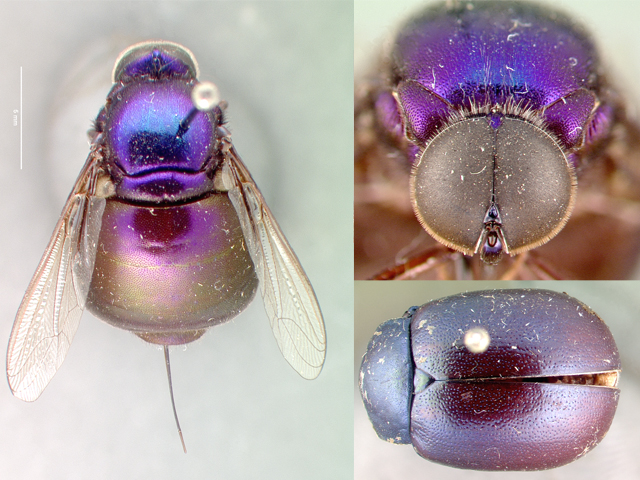 Kozarec kozarca: Fotografije April Nobile, Cas
Kozarec kozarca: Fotografije April Nobile, Cas
Večinoma muhe niso žuželka, nad katero se preveč navdušujem. Vendar, Izjema je enigmatična družinska acroceridae. Občasno bom začel deliti nekaj zanimivih rodov – Morfologija družine je neverjetno raznolika. Večino mojih dni preživim v muzejskem inventarju in naša množična zbirka 16,000 Akorceridi (aka majhne muhe). To morda ne zveni vse preveč impresivno, če ga primerjate z drugimi bolj obilnimi družinami (in v primerjavi s čezmej 17,500,000 drugi vzorci, ki jih imamo v muzeju); Toda izkazalo se je, da predstavlja veliko, Če ne večina, od vse znani primerki za vso družino. Medtem ko obstajajo verjetno veliki sklopi teh muh v drugih institucijah, Kalifornijska akademija znanosti zlahka zahteva rekord, odkar je prejela zbirko DR. EVERT I.. Schlinger (ki občasno pride v službo iz muzeja).
Acroceridi se izkažejo za precej težka skupina, ki jo je treba preučiti zaradi tega, kako redki so v naravi, njihova parazitoidna biologija, in kako težko jih je ujeti na krilo. Njihov velik prsni koš je poln mišic, ki raketirajo lete po zraku – Torej, če jih ne ujamete na roži, ostanete hrepenenje po slabi. Ev mi je povedal eno zgodbo o učenju, da jih ujamem na krilo v Kostariki. Stojiš navzdol od kolega na terenu – Takoj, ko nekdo sliši nekaj zadrge mimo, divje zamahnete v upanju, da boste po naključju zaskočili letenje… Vsake toliko deluje. Te muhe so tudi edini znani endoparaziti pajkov za odrasle (Morda je zapis tahinida…). Zgornji rod, NeoKozarec, je parazit terafosidnih tarantul (nekaj takega Aphonopelma). Kot ličinke muha deluje po nogah pajka in se vpelje v trebuh, kjer se nato usede zraven knjige pljuča in pokuka malo dihalne luknje. Potem potrpežljivo čaka, da pajek skoraj zrelo. Z ženskami tarantulami, muha bi lahko bila mirujoča desetletja. Sčasoma se zgodi nekaj podobnega filmu in ličinke se prehranjujejo z notranjimi organi pajka. Toda ugotovitev, ali ima pajek ali ne, je nemogoče brez disekcije – Tako je treba vzdrževati velike zbirke pajkov v živo, da pridobijo zapise gostiteljev. Parazitoidna biologija je prav tako kul.
Zgornji vzorec (Kozarec kozarca nov, neimenovan, vrste) je bilo zbrano v 1977 avtor Schlinger v bližini mesta Alamos, Mehika – na rožah z verjetno modelom mimičnega modela, Chrysomelidae hrošč (ljudje hrošča, kakršne koli ideje, ki presegajo družino?).

Very interesting! Out of curiosity, because you mention large collections of live spiders, has any researcher reached out to the hobby tarantula keepers in a quest for specimens? While I have never seen something as spectacular as the above emerge from a wild caught tarantula, I have heard from a few people who ended up with “strange” flies in the past…
Reaching out to them for actual tarantulas has lead to quite a few specimens for Brent Hendrixson on his revision of the genus Aphonopelma, at least for the USA native species. There also are frequently imports of various species brought in from Central and South America, which is not a practice I like or am comfortable with…but it might lead to at least a few specimens given the numbers involved. Just a thought.
I think the answer is somewhat. I’ve reached out on message boards and even recently gave a short talk to the SF Bay Area Tarantula Society. The problem comes down to peoples immediate response when they see a giant grub crawling out of their spider – they reach in and grab their prize specimen and in the process damage the larvae or pupae of the emerging fly. As it turns out these flies are pretty sensitive before pupating and while I’ve seen lots of maggot images, never seen a fly reared by a hobbyist. I think the biggest hurdle is that people only discover what they are after they have had a spider die – and chances are it’ll be years before another one of their wild caught immature spiders are parasitized!
That makes a lot of sense, I guess it didnt really occur to me that for most people having a parasite emerge from one of their captives is a bad thing…that sort of thing would make my day. 🙂
Especially if that spider cost you a few hundred dollars!!
I wonder if that fly sees very well. 🙂
First impression of the beetle is a species of Chrysolina (subfamily Chrysomelinae), but my knowledge of Neotropical chrysos is limited.
Thanks for the genus ballpark – I’ll have to dig through our collections here to see if I can’t narrow it down more.
Did you mean that these acrocerid flies are the only known dipteran endoparasites of adult spiders? There are certainly spider-parasitic nematodes, and mantidfly larvae can crawl into the book lungs of their spider hosts and feed on hemolymph while hitching a ride to the egg deposition site.
http://en.wikipedia.org/wiki/Mantispidae
And here’s a cool post about a mantidfly larva on a spider, preserved in amber!
http://blogs.discovermagazine.com/notrocketscience/2011/03/28/spider-boarding-insect-preserved-in-amber/
(Seveda, that one’s on the outside of the spider, but the post also has more info on other tactics.)
Thank you for pointing that out! You’re correct of course, when I was thinking “no other endoparasitoids” I totally neglected non-insects such as nematodes. I should have recalled how tricky it can be to control nematode infestations in captive bread spiders!
I also did not know that about mantidflies. Actually I should catch up on the literature, there may be other diptera or hymenoptera parasitoids more recently known. Very cool, thanks for the link.
Augh augh augh and here’s a picture of a huuuuuge nematode coming out of a spider! It’s even one of the behavior-modifying parasites — it induces its host to seek out water before dying, so the nematode can complete its life cycle. (Like the horsehair worm in crickets!)
http://www.abc.net.au/science/k2/stn/spider.htm